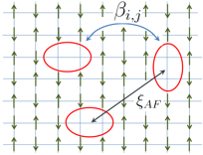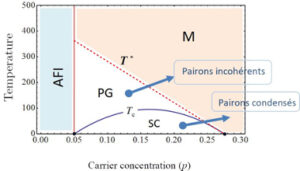List of members |
Facilities |
Internships and jobs |
PhD |
Publications |
News |
Team
- Permanent member: Yves Noat
Physics of superconducting cuprates
Since 1986, date of their discovery by Bednorz and Müller, superconducting cuprates continue to fascinate physicists. Our group was one of the first, in the 1990s, to measure the excitation spectrum of the quasiparticles of these materials. These measurements have revealed unconventional signatures such as the presence of a low-temperature pseudogap (in the presence of disorder) or the famous “peak-dip-hump” in the tunnel spectra.
The main characteristics of cuprates can be summarized as followed:
- Parent compounds are antiferromagnetic insulators,
- High critical temperatures Tc
- The Tc curve follows a dome as a function of doping (the superconducting dome).
- Existence of a pseudogap phase beyond Tc and in the vortex cores
- Very short coherence length
Several fundamental questions still need to be resolved in order to achieve a complete understanding of the physics of these compounds:
- How are pairs formed?
- What is the nature of the superconducting condensation?
- What is the relationship between the superconducting state and the pseudogap phase?
In close collaboration with two researchers from IMPMC (Sorbonne University, CNRS, MNHN), William Sacks and Alain Mauger, we have recently proposed a theoretical model to explain in a coherent way the superconductivity in cuprates.
The key points of the model are:
- The formation of pairs of holes, or ‘pairons’ that bind together in their environment local antiferromagnetic [1].

Figure 1: Bound pairs of holes, or ‘pairons’ in their local antiferromagnetic environment.
- The superconducting state is formed through the interaction between pairs, whose energy is directly related to the critical temperature Tc [2].
- Existence of two energy scales: the matching energy or gap Δp which decreases linearly with the doping, and the energy of interaction between pairs βc that follows the dome superconductor. The first scale is related to the pseudogap temperature T*, while the second is proportional to the critical temperature Tc [2].
- Coexistence of two types of excitations: excitations of bosonic-type pairs, following the Bose-Eintein statistic, and excitations of fermionic-type quasiparticles [3].

Figure 2: Phase diagram of the model as a function of doping. In the superconducting state, the pairons are condensed in the coherent superconducting state while they are incoherent in the pseudogap phase, whose characteristic temperature is T*. The superconducting dome follows the interaction between pairons which is proportional to the critical temperature Tc.
The model allows to describe:
- the tunnel excitation spectrum as a function of temperature, for the different dopings [1,2].
- the ARPES measurements and in particular the appearance of the Fermi arcs [3],
- variations of the gap as a function of the angle of the wave vector in the reciprocal space (nodal gap vs antinodal gap) [4].
- and finally thermodynamic measurements [5].
The next step consists in confronting the model with the description of the magnetic and electronic transport properties. This will be the subject of our next works.
Main collaborations
William Sacks, Alain Mauger, IMPMC (Sorbonne Université)
Recent publications
[1] W. Sacks, A. Mauger, Y. Noat. Cooper pairs without glue in high-Tc superconductors: a universal phase diagram. Europhys. Lett. 119 17001 (2017). https://doi.org/10.1209/0295-5075/119/17001
[2 ] W. Sacks, A. Mauger, Y. Noat, Pair–pair interactions as a mechanism for high-Tc superconductivity, Supercond. Sci. Technol. 28 105014 (2015). https://doi.org/10.1088/0953-2048/28/10/105014
[3] W. Sacks, A. Mauger, Y. Noat, Origin of the Fermi arcs in cuprates: a dual role of quasiparticle and pair excitations, J. Phys. Condens. Matter 30 (2018) 475703. https://doi.org/10.1088/1361-648X/aae7af
[4] Y. Noat, A. Mauger, W. Sacks, Single origin of the nodal and antinodal gaps in cuprates, Europhys. Lett. 126 67001 (2019). https://doi.org/10.1209/0295-5075/126/67001
[5] Y. Noat, A. Mauger, M. Nohara, H. Eisaki, W. Sacks, How ‘pairons’ are revealed in the electronic specific heat of cuprates, Solid State Communications, Volume 323, 114109 (2021) https://doi.org/10.1016/j.ssc.2020.114109

